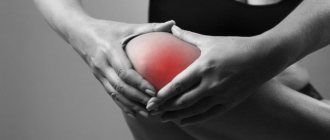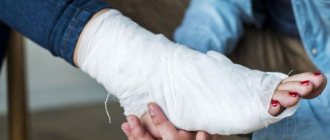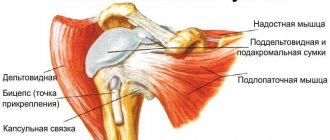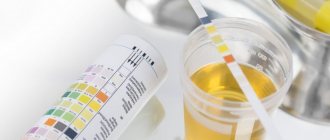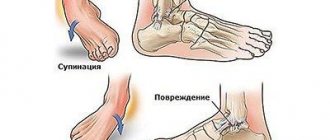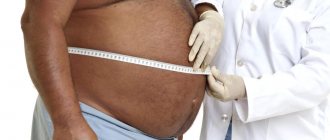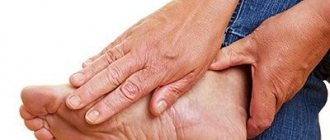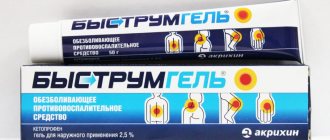The lower extremities of a person are subject to frequent mechanical stress, so it is not surprising that many patients complain of ankle ligament injuries. Up to 12% of cases of damage to this joint occur due to tears and sprains. This problem is especially relevant for athletes, but no less often people with injuries after falls on a slippery plane go to emergency rooms. Clinical manifestations are individual, their intensity is determined by the severity of the injury and the presence of accompanying disorders. Patients complain of pain, stiffness in limb movement, and swelling. Therapeutic effects include physical therapy, leg immobilization, massage procedures, and the prescription of painkillers and anti-inflammatory drugs.
The ArthroMedCenter Joint and Spine Clinic has been treating sports injuries of various types for many years. The Center’s specialists offer effective treatment for damaged tissue - MBST therapy.
Principles of treatment of ankle ligament injuries
Damage to the ankle ligaments and a diagnosis of sprain or rupture can only be determined after examination by an orthopedist. For these purposes, a visual examination, palpation of the area, examination of an x-ray, and, if necessary, an MRI are carried out. Treatment of ankle ligament injuries can be carried out on an outpatient basis or in a hospital. As a rule, joint immobilization methods or surgical restoration are used.
Mild stage ligamentous deformities require stabilization with special bandages. The position of the fibers is fixed with a tight bandage. Doctors may prescribe anti-inflammatory drugs, as well as medications to stimulate blood flow in the leg area.
Treatment of damage to the ligaments of the ankle joint in cases of moderate injuries is usually carried out in combination with the prescription of painkillers, by applying a bandage to ensure the strength of the attachment of the fibers to each other. During the first period, rest is required, and you can move on to therapeutic exercises on an individual basis only 14 days after the injury.
The standard therapeutic process requires the use of a bandage or plaster cast, as well as restorative procedures. As a result, complete stabilization of the ankle joint can be achieved in 8-9 weeks. If conservative treatment of ankle ligament damage is not sufficiently effective, then surgical intervention is prescribed, for example, invasive reconstructive surgery is performed. If the ligaments are completely torn when surgery was performed, the rehabilitation period lasts several months.
Conservative treatment methods are quite effective, but make the healing and recovery process quite lengthy. ArthroMedCenter specialists offer an innovative method for treating sprains using MBST therapy.
Factors that can cause ligament rupture
The ankle is an area that is subject to constant stress when walking and almost any sport. Therefore, ankle ligament ruptures are widespread. The ligaments located here are very sensitive and vulnerable. During training, rotational injuries of the ankle ligaments very often occur.
As for everyday situations, many of us in everyday life have had to deal with such a problem as ruptured ligaments in this area. One awkward movement - and my leg twisted. Such cases have probably happened to everyone in life, but the consequences are different for everyone. Some will get away with a slight fright, others will receive serious injury. And the point here is not only in the strength of the impact, but also in the characteristics of the body.
In many ways, the degree of rupture depends on the provoking factors:
- the presence of flat feet or club feet;
- excess weight;
- previous ankle injuries;
- age-related degenerations (as a consequence - poor blood supply);
- wearing tight, uncomfortable shoes (women often twist their ankles due to high heels and, as a result, suffer ligament damage).
The knee is the part of the limb that suffers the most from jumping, bad landings, and impacts to the hips and shins. Active, extreme sports often lead to such injuries. You should know that these types of ruptures threaten to result in arthritis or arthrosis.
The shoulders and elbow suffer the most under increased loads of the same type: regular heavy lifting, for example. Ligaments in the joints of these areas also often rupture when falling on the hand.
Specialists at the OSTEO POLY CLINIC point out that smoking and other bad habits that impair the flow of blood and nutrients are negative factors that can increase the risk of ligament damage.
Muscle weakness caused by age-related changes or frequent use of corticosteroids also has a detrimental effect on the condition of joints and ligaments.
A fact that requires special mention is the presence of osteophytes, which can cause ligament ruptures. These are bone growths that occur after 40-45 years, the sharp edges of which cut the ligaments and provoke a rupture.
Treatment of ankle ligament rupture with MBST therapy
MBST is a therapeutic magnetic resonance that is used in clinical practice in several programs. The programs are designed to restore cartilage in the spine, hips, knees, shoulders, feet and hands. MBST therapy is an effective treatment for torn ankle ligaments, as well as other sports injuries and pathologies of the musculoskeletal system.
The principle of operation of this therapeutic method is based on the fact that tissue metabolism is regulated by electric and magnetic fields. And if in a healthy organ or system the processes of regeneration, that is, renewal, occur independently, then in case of dysfunction they require impulse influence from the outside. In MBST therapy, magnetic resonance is used as such an impulse, which sends signals to the tissues affected by the disease, reproducing the signals of a healthy body system. Normalized metabolism allows you to resume the regeneration process in the cells of cartilage, bone tissue, tendons, etc. This allows you to eliminate the cause of disorders of the musculoskeletal system, and not only relieve the patient from the unpleasant symptoms of the disease.
Tear of the lateral ligament of the knee joint
Tear of the collateral ligament is a pathology of the elderly. They develop various degenerative processes in the knee joint:
- the height of the cartilaginous synovial layer covering the heads of the tibia and femur decreases;
- the cartilage tissue of the meniscus is destroyed, it stops functioning normally and ensuring the stability of the position of the condyles of the bones;
- ligaments and tendons are stretched and deformed;
- the muscles surrounding the knee joint partially atrophy;
- Joint instability, tendency to twisting and dislocation occurs.
Partial tearing of the ligaments for the first time can occur with significant traumatic impact. This could be a dislocation or serious bruise of the leg. Then, after the formation of scar tissue, tearing of the lateral ligament of the knee joint will be repeated at the slightest instability of the joint until the integrity of the ligament tissue is completely damaged.
In old age, a tear of the lateral ligament of the knee is dangerous because, in the absence of timely treatment, it provokes the development of deforming osteoarthritis and leads to the fact that a person loses the ability to move independently.
Treatment of torn ankle ligaments at ArthroMedCenter
The course of treatment is 7 or 10 procedures, 1 hour per day. At this time, the patient lies on the device and “receives” the incoming energy without feeling discomfort.
There are special programs lasting 3 days that are used for athletes after intense competitions and training, for people at high risk of developing osteoarthritis, and also to prevent damage to cartilage tissue in rheumatoid arthritis, as well as ankylosing arthritis. Magnetic resonance therapy uses the energy produced by our own hydrogen atoms to heal. In some way, sports injuries are treated with bioenergy, and therefore its use is not associated with consequences for the body and the risk of complications. The procedure can be repeated without restrictions.
Features of ankle ligament damage
From an anatomical and physiological point of view, this process is considered as a deformation change or damage to bundles of fibrous type connective tissue. It is this tissue that ensures the retention of the articular joint. The nature of the injuries is determined by motor and sports overloads, unintentional misalignment of the foot on the plane.
Damage also appears as a result of excessive body weight and the use of uncomfortable shoes. The vast majority of injuries occur to the outer ligamentous fibers, but the inner collagen bands are stronger in structure and less susceptible to damage.
Thanks to the ligaments, the basis is created for the stability of the position of the ankle joint and for the performance of motor functions. As a result of a violent change in the condition of the joint, the following sprains of ligament bundles occur:
- 1st degree damage is a mild injury when the fibers are in a stretched state, pain is felt, but its intensity is insignificant and does not interfere with motor activity. In this case, no changes in the color or volume of the tissues are observed.
- Damage 2nd degree. Moderate injuries are accompanied by partial rupture of some fibers, which leads to the formation of edema and the appearance of cyanosis in the area. The patient complains of severe pain.
- 3rd degree injuries. These are severe violations of the integrity of the ligaments when they are completely torn, which eliminates the possibility of independent movement. Hematomas form in the affected area, the pain is acute.
In the event of a sprain, the risks of subsequent complications and leg injuries increase. A person has problems with stability when walking, and there is stiffness in movements. That is why timely medical attention and adequate treatment of ankle ligament damage is required.
Recovery after a torn ligament
The recovery stage after a torn ligament begins 10 to 14 days later. At this time, it is necessary to begin rehabilitation; if this is not done, then ankylosis, contracture and cicatricial deformation of the ligament may develop.
Restoration of torn knee ligaments is carried out using manual therapy methods:
- massage and osteopathy trigger the process of impaired microcirculation of blood and lymphatic fluid at the site of traumatic disruption of tissue integrity;
- therapeutic exercises and kinesiotherapy strengthen the surrounding muscles, increase their tone, increase the elasticity of ligaments and tendons;
- physiotherapy and laser treatment speed up the healing process and prevent the formation of excess scar tissue;
- reflexology starts the process of natural regeneration of damaged tissues.
The rehabilitation course is developed individually, taking into account the characteristics of the patient’s health condition. If you need rehabilitation after a knee ligament injury, make an appointment with a free orthopedist at our manual therapy clinic.
Symptoms
The manifestations of damage depend on the severity of the problem. In case of a 1st degree injury, the pain is usually mild and is felt during movement or when the ligament and the joint itself are palpated. Edema and swelling are possible, but they are mild and appear in the area of attachment of the ligaments. Despite mild pain, the functionality of the joint does not change, the person can move independently
With a partial rupture of the ligament, characteristic of the 2nd stage of the disease, the swelling is already significant. It covers the front and outer areas of the foot. During palpation, the pain is significant; it is more disturbing at the point of the tear. The patient complains of difficulty moving, as the pain will intensify. A characteristic feature of the first two stages is the difficulty of detecting deviations on x-rays.
The pain accompanying stage 3 injuries is already so severe that a person cannot stand on the affected limb. Puffiness and swelling are clearly visible, and there are serious signs of hemorrhage. They quickly spread along the foot, moving to the sole area. If a complete ligament rupture occurs, then there is a possibility of a piece of bone tearing off at the attachment site. This is clearly visible on x-rays.
Symptoms of a torn knee ligament
A knee ligament tear can only be diagnosed with an MRI examination. But after the injury, it is necessary to take an x-ray, which will exclude a violation of the integrity of the bone tissue. The main clinical symptoms of ligament tears include:
- acute pain that does not allow you to fully step on the injured leg;
- rapid increase in swelling of the surrounding soft tissues;
- the appearance of bruises and hematomas in the area of injury;
- impaired mobility (the patient can hardly bend or straighten the leg independently, depending on which ligament is damaged).
There are specific symptoms of knee ligament tears, for example, when the anterior cruciate is damaged, drawer syndrome occurs. The lower leg is no longer fixed in the vertical projection and can be moved forward without much effort. When the posterior cruciate ligament is damaged, the tibia moves backward. When the lateral ligaments are torn, the joint becomes unbalanced and pathological mobility appears. When you try to step on your foot, you get the feeling that it is twisting in one direction or another.
Clinical symptoms of knee ligament tears are similar to other types of injury. Therefore, only an orthopedist can make an accurate diagnosis based on an MRI image. A preliminary diagnostic and therapeutic puncture of the joint capsule can be performed. If fresh blood is obtained during this procedure, then there is a high probability of complete or partial rupture of the ligament. When excess fluid is removed, the patient experiences temporary pain relief. Symptoms may completely subside within 2 to 3 weeks. But without proper treatment and rehabilitation, this will only mean the formation of an excess amount of scar tissue, which will rupture at the first excessive physical exertion.
First aid
Qualified assistance immediately after an injury will minimize complications and prevent the inflammatory process from spreading to the area of the foot, ankle or knee. Before visiting the emergency room you must:
- Fix the ankle joint. To do this, remove shoes and immobilize the damaged area of the limb using a fixing bandage. Use an elastic bandage or a long piece of high-strength fabric. The bandage is applied in smooth figure eights and not too tight knot fastening.
- Creating a comfortable position - the leg is raised and placed on a pillow or bolster. This is necessary to limit the spread of swelling. Elevating the limb while treating an ankle ligament injury will speed up the healing process.
- Consistent cooling of the diseased joint area. Immediately after injury, ointments with a cooling effect are usually not used. A more effective approach would be to use ice cubes. They are placed in a bag that is hermetically sealed, and then wrapped in a piece of fabric. The latter is especially important to prevent frostbite. Instead of ice, you can take frozen meat or fish, or a container with frozen vegetables. Such compresses are kept on the limb for no more than 10-15 minutes, after which you should take a break for 20-25 minutes. and repeat the manipulation.
What not to do if you are injured
It is important not only to adhere to the doctor’s instructions, but also to take precautions. Experts prohibit:
- Make compresses with vodka or alcohol, since ethanol, after passing into the tissue, provokes active blood clotting.
- Do not remove the bandage at night. It should definitely be removed before bed to activate blood flow and recovery processes.
- Use dry or moist heat in the first days after damage. Treatment with baths, heating pads or compresses is not advisable during this period.
- Carry out massage treatments yourself. This method is permitted only after the symptoms of damage have been eliminated and the rehabilitation period has begun.
- Load the limb. Treatment of ankle ligament damage requires rest without stress or movement.
Moscow, metro station Dubrovka, st. Sharikopodshipnikovskaya, 6/14
| Loading map... |
